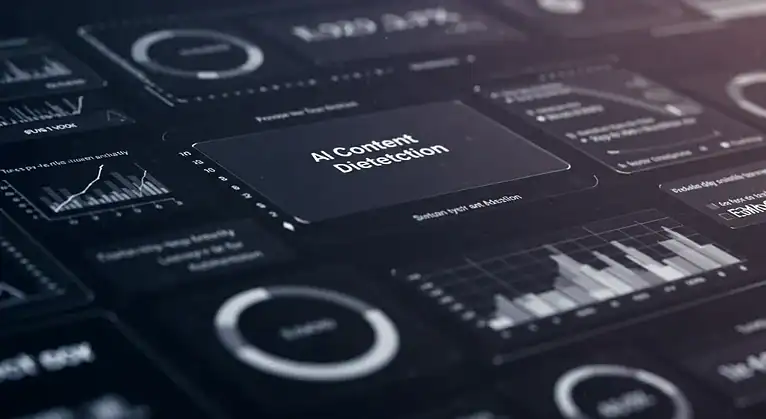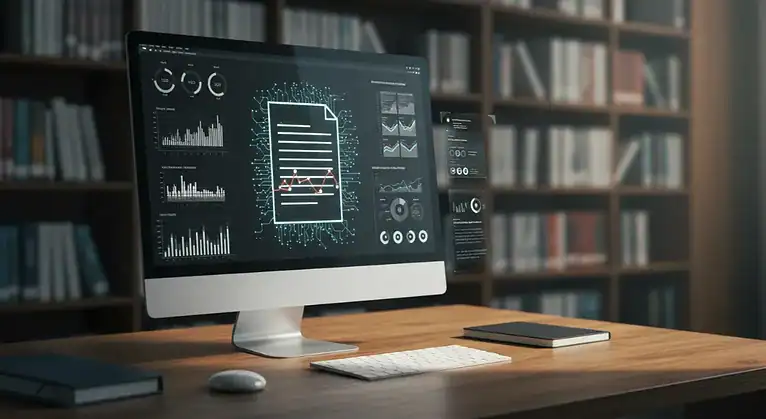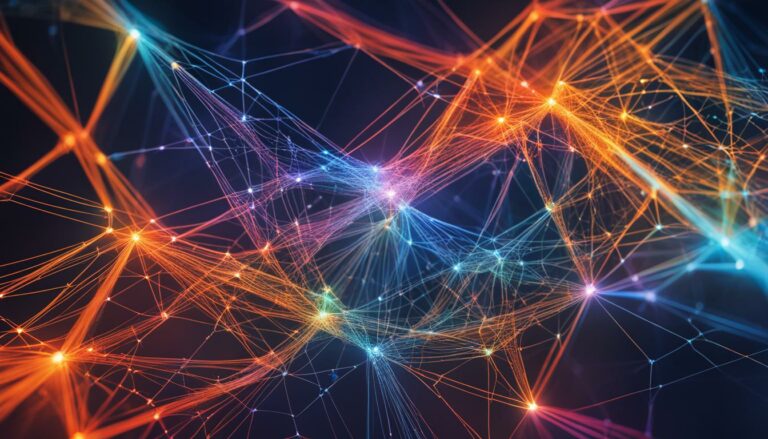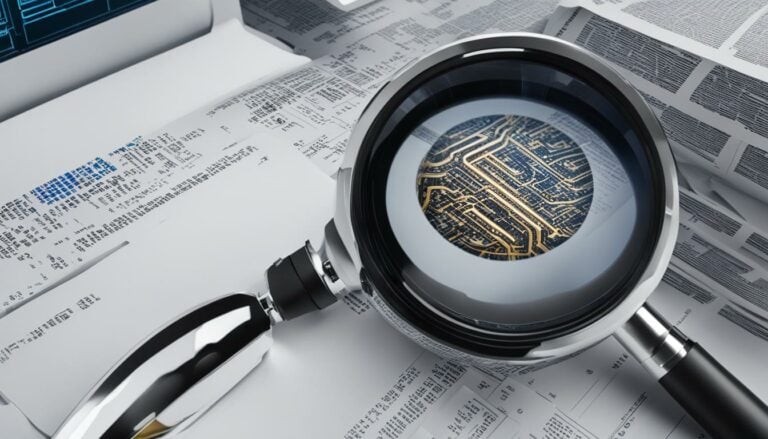Turnitin AI Detection: How It Works & Accuracy in 2025
Welcome to this article where we will discuss the Turnitin AI detection feature and its numerous advantages. In today’s academic landscape, it has become crucial to have effective systems in place to detect AI-assisted writing and AI language models. Turnitin, a leading provider in academic integrity solutions, offers a free AI detection feature that can help educators identify instances of AI-generated content in student assignments.
Turnitin’s AI detection technology has been specifically developed and trained on academic writing, making it highly effective in detecting dishonesty in student work. By signing up with Turnitin, educators not only gain access to this cutting-edge technology but also have the opportunity to contribute to the shaping of future AI detection tools.
Key Takeaways:
- Turnitin offers a free AI detection feature to help educators identify AI-generated content in student work
- The technology is specifically trained on academic writing, making it highly effective in detecting dishonesty
- Educators can sign up with Turnitin to shape the future of AI detection tools
The Importance of AI Content Detection

With the rise of AI writing tools, it has become crucial to have effective AI content detection systems in place. Turnitin’s AI detection feature helps maintain academic integrity by detecting instances of plagiarism and improper use of sources in student work. The Similarity Report provided by Turnitin compares submitted work against an extensive database to identify potential instances of plagiarism. The AI writing indication feature helps educators identify text segments within a document that have been generated by AI language models.
Plagiarism is a serious offense that undermines the learning process and academic integrity. AI-generated content has made it easier for students to cheat by producing essays, papers, and assignments that are not their own original work. Traditional plagiarism detection methods may not be sufficient to identify these instances, as AI algorithms have become highly sophisticated in mimicking human writing styles.
Turnitin’s AI content detection feature addresses this challenge by utilizing advanced algorithms and machine learning techniques to identify AI-generated text. The system breaks down submitted work into several hundred-word segments and assigns each segment a score between 0 and 1, indicating the likelihood of AI generation. This allows educators to identify and address potential instances of AI-generated content in student work, promoting academic integrity and ensuring fairness in the evaluation process.
The Role of AI Content Detection in Upholding Academic Integrity
Academic integrity is a cornerstone of education, fostering a culture of honesty, trust, and intellectual growth. The use of AI content detection tools like Turnitin’s AI detection feature plays a crucial role in upholding this integrity by identifying instances of plagiarism and AI-generated content. By detecting and discouraging academic dishonesty, such tools encourage students to develop their own critical thinking and writing skills, ultimately enhancing the educational experience.
Table: Comparison of AI Content Detection Tools
| AI Content Detection Tool | Accuracy Rate |
|---|---|
| Turnitin | 98% |
| GPTZero | 85% to 98% |
| Copyleaks | 99.12% |
| Originality | 94% |
While Turnitin is one of the most popular AI content detection tools with a 98% accuracy rate, it is important to note that no tool can guarantee complete accuracy. Each tool has its own strengths and weaknesses, and educators may choose the tool that best aligns with their specific needs and requirements.
In conclusion, AI content detection is of utmost importance in maintaining academic integrity and preventing plagiarism. Turnitin’s AI detection feature, along with other AI content detection tools, provides educators with valuable insights to identify instances of AI-generated content, fostering a fair and honest learning environment. By leveraging these tools, educators can uphold academic standards, promote originality, and ensure the integrity of the educational process.
How Turnitin’s AI Detection Works
Turnitin’s AI detection system employs a sophisticated approach to identify AI-generated content in student submissions. The process involves breaking down the submitted work into several hundred-word segments and scoring each segment on a scale of 0 to 1, indicating the extent to which it is AI-generated. A score of 0 suggests that the segment is not AI-generated, while a score of 1 indicates that the entire segment is AI-created. These scores are then averaged to predict the overall presence of AI-generated text in the submission.
The AI detection algorithm developed by Turnitin is specifically trained to recognize popular language models like GPT-3 and GPT-4. By analyzing the linguistic patterns and characteristics of AI-generated writing, the system can differentiate between AI and human-authored content. Turnitin continuously refines its AI detection model to adapt to the evolving landscape of AI language models, ensuring its effectiveness in identifying AI-generated content.
Additionally, Turnitin’s AI detection system features an AI writing indication capability, enabling educators to pinpoint specific text segments within a document that have been generated by AI language models. This helps educators gain deeper insights into the use of AI-generated text and facilitates informed discussions with students about academic integrity.
Benefits of Turnitin’s AI Detection System
- Accurate Identification of AI-Generated Content: Turnitin’s AI detection system offers a reliable method of identifying AI-generated text in student work, allowing educators to detect instances of academic dishonesty and maintain academic integrity.
- Effective Evaluation of Student Work: By providing educators with information about the presence of AI-generated text, Turnitin’s AI detection system enables them to evaluate student submissions more accurately and engage in meaningful discussions about originality.
- Rigorous Training and Continuous Updates: Turnitin’s commitment to transparency and continuous refinement of its AI detection system instills confidence in educators, ensuring that they have access to a reliable tool for evaluating student work.
| Text Segment | Score |
|---|---|
| Introduction | 0.10 |
| Main Body | 0.05 |
| Conclusion | 0.12 |
| References | 0.08 |
“Turnitin’s AI detection system offers educators valuable insights into the use of AI-generated text in student work, helping to maintain academic integrity and facilitate informed discussions about originality.”
In summary, Turnitin’s AI detection system employs a scoring system to identify AI-generated text in student submissions. The system is trained to recognize popular language models and continuously updated to adapt to the evolving AI landscape. It provides educators with the ability to evaluate student work accurately and engage in discussions about academic integrity. Turnitin’s commitment to transparency and continuous refinement ensures the reliability and effectiveness of its AI detection capabilities.
Accuracy of Turnitin’s AI Detection

When it comes to detecting AI-generated content, Turnitin boasts an impressive accuracy rate of 98%. This high level of accuracy is achieved through extensive testing and refining of its algorithms. However, it’s important to note that no detection tool is perfect, and false positives can still occur.
Turnitin has taken measures to minimize false positives, with a false positive rate below 1%. The reliability of the detection system can vary depending on the percentage of AI content in the submitted work. On average, Turnitin’s AI detection system provides an accuracy rate close to 96% in reality. This means that educators can have a high level of trust in the system’s ability to identify AI-generated text in student work.
Despite the impressive accuracy rate, it’s crucial to approach the results provided by Turnitin’s AI detection feature with cautious analysis. Educators should consider the scores as indications and further examine the flagged content before making any final decisions on academic misconduct. The complexity of AI writing and the emergence of sophisticated AI language models pose ongoing challenges for detection tools like Turnitin.
| Accuracy Rate | False Positive Rate |
|---|---|
| 98% | Below 1% |
In conclusion, while Turnitin’s AI detection feature offers a highly accurate way to identify AI-generated content, it’s important to acknowledge its limitations and exercise careful judgment when interpreting the results. Turnitin continues to refine its algorithms and stay updated with evolving AI technology to ensure educators have reliable tools to maintain academic integrity.
False Positives and Challenges of AI Content Detection
While AI content detection tools like Turnitin have made significant progress in detecting AI-generated text, there are still challenges and false positives that arise in the process. False positives occur when the tool incorrectly identifies human-authored content as AI-generated. This can happen when AI language models closely emulate human writing styles, making it difficult for the detection tools to accurately distinguish between human and AI-generated text.
The challenge lies in the ever-evolving landscape of AI technology. As AI language models continue to advance, they become more proficient at generating text that closely resembles human writing. This makes it crucial for AI content detection systems to constantly adapt and refine their algorithms to stay ahead of these advancements. Turnitin and other similar tools are actively working to improve accuracy and minimize false positives, but it remains an ongoing challenge.
As educators, it is important to be aware of the limitations of AI content detection tools. While they provide valuable insights, they should be considered as indications rather than definitive proof of AI-generated content. It is essential to further analyze the flagged segments and take into account other factors before making final decisions on academic misconduct.
Challenges in AI Content Detection
The challenges in AI content detection go beyond false positives. With the complexity of AI writing, it becomes increasingly difficult to accurately identify instances of AI-generated text. AI language models like GPT-3 and GPT-4 have the ability to produce text that is almost indistinguishable from human-authored content. This poses a significant challenge for detection tools like Turnitin, as they must constantly refine their algorithms to accurately detect AI-generated text.
Table: Comparison of AI Content Detection Tools
| AI Content Detection Tool | Accuracy Rate |
|---|---|
| Turnitin | 98% |
| GPTZero | 85% – 98% |
| Copyleaks | 99.12% |
| Originality | 94% |
Table: Comparison of AI Content Detection Tools
- Turnitin – 98% accuracy rate
- GPTZero – 85% to 98% accuracy rate
- Copyleaks – 99.12% accuracy rate
- Originality – 94% accuracy rate
Each AI content detection tool has its own reliability and accuracy rates. While Turnitin is one of the most popular tools, it is essential to consider the specific needs and requirements of your educational institution before making a selection.
Comparison with Other AI Content Detection Tools

When it comes to AI content detection, Turnitin is one of the most popular tools available. However, it is important to note that there are other options on the market that offer reliable AI detection capabilities. Two notable tools are GPTZero and Copyleaks. Let’s take a closer look at how these tools compare in terms of reliability.
GPTZero
GPTZero is known for its accuracy in detecting AI-generated content. With an accuracy rate of 85% to 98%, it provides educators with a reliable solution to identify instances of plagiarism and improper use of sources. The tool uses advanced algorithms to analyze submitted work and compare it against a vast database, flagging any potential issues. GPTZero is constantly updating its technology to keep up with the ever-evolving landscape of AI language models.
Copyleaks
Copyleaks is another popular AI content detection tool that boasts an impressive accuracy rate of 99.12%. Educators can rely on Copyleaks to detect instances of AI-generated text and ensure academic integrity. The tool uses advanced algorithms and machine learning techniques to analyze submitted work and identify similarities with external sources. With its high accuracy rate, Copyleaks provides educators with the confidence they need to evaluate student work.
Originality
Originality is yet another AI content detector that offers a reliable solution for educators. With an average accuracy rate of 94%, it helps identify instances of AI-generated content and maintain academic integrity. Originality uses sophisticated algorithms to assess submitted work and compare it against a comprehensive database of sources. While it may have a slightly lower accuracy rate compared to GPTZero and Copyleaks, it still provides valuable insights for educators.
| Tool | Accuracy Rate |
|---|---|
| GPTZero | 85% – 98% |
| Copyleaks | 99.12% |
| Originality | 94% |
Benefits of Turnitin AI Detection
Turnitin’s AI detection feature offers several benefits to educators in maintaining academic integrity and ensuring the originality of student work. By identifying instances of AI-generated content, Turnitin helps educators evaluate the authenticity of assignments and engage in meaningful discussions about originality with students. The accuracy and effectiveness of Turnitin’s detection system instill confidence in educators, enabling them to make informed decisions about the academic integrity of student work.
One of the key benefits of Turnitin AI detection is its ability to detect AI-generated content in student work, which helps educators maintain academic integrity. By flagging potential instances of AI-generated text, Turnitin ensures that students are not relying on AI tools to produce their assignments. This promotes fair evaluation and encourages students to develop their critical thinking and writing skills, enhancing their educational experience.
With Turnitin’s AI detection feature, educators gain access to reliable information about the extent of AI-generated content in student assignments. This enables educators to have informed discussions with students about proper citation, plagiarism, and the importance of originality in academic work. By detecting AI content, Turnitin helps educators reinforce the value of honest and authentic writing, fostering a culture of academic integrity within educational institutions.
The Role of Turnitin in Maintaining Academic Integrity
Turnitin’s commitment to transparency and continuous updates ensures that educators have access to the most up-to-date tools for evaluating student work and maintaining academic integrity. The rigorous training and testing of Turnitin’s AI detection system result in greater accuracy in identifying AI-generated content, enabling educators to make fair assessments and judgments about student assignments.
By utilizing Turnitin’s AI detection feature, educators can confidently evaluate the originality and authenticity of student work, promoting academic integrity and deterring dishonest practices. Turnitin’s ongoing efforts to refine its algorithms and adapt to the evolving landscape of AI language models demonstrate its dedication to providing educators with reliable tools to address the challenges posed by AI-generated content.
| Benefits of Turnitin AI Detection |
|---|
| Identifies instances of AI-generated content |
| Enables meaningful discussions about originality |
| Promotes fair evaluation and critical thinking |
| Reinforces the value of honest and authentic writing |
| Ensures access to up-to-date evaluation tools |
| Enhances academic integrity in educational institutions |
Limitations of Turnitin AI Detection

While Turnitin’s AI detection feature is effective in identifying AI-generated content, it is important to acknowledge its limitations. No tool can provide 100% reliability and accuracy in detecting AI content, as there are ways to bypass AI detection. The complexity of AI writing and the sophistication of AI language models pose challenges for detection tools, making it difficult to distinguish between AI-generated and human-authored content.
Turnitin’s AI detection system breaks down submitted work into segments and assigns a score to each segment to determine the extent of AI-generated text. However, there is a possibility of false positives, where content written by humans may be flagged as AI-generated. The system’s accuracy also varies based on the percentage of AI content in the submitted work.
Educators should consider Turnitin’s scores as indications and further analyze the issue before making final decisions on academic misconduct. It is important to engage in meaningful discussions with students and evaluate the context of the flagged content. The goal is to ensure fairness and maintain academic integrity while using Turnitin’s AI detection as a tool to support the evaluation process.
“The complexity of AI writing and the sophistication of AI language models pose challenges for detection tools.”
Overview of Limitations:
- No tool can provide 100% reliability and accuracy in detecting AI content
- Possibility of false positives, flagging human-authored content as AI-generated
- Varying accuracy based on the percentage of AI content in submitted work
- Challenges in distinguishing between AI-generated and human-authored content
| Limitations | Impact |
|---|---|
| Potential false positives | May result in incorrectly flagging human-authored content as AI-generated |
| Varying accuracy | Dependent on the percentage of AI content in the submitted work, affecting the reliability of AI detection |
| Challenges in distinguishing | The complexity of AI writing and sophisticated AI language models make it difficult to accurately identify AI-generated text |
The Future of AI Content Detection
As AI technology continues to evolve at a rapid pace, the future of AI content detection holds great potential. Turnitin and other AI detection tools are constantly adapting their algorithms to keep up with the advancements in AI language models. The goal is to minimize false positives and improve the accuracy in distinguishing between AI-generated and human-authored content.
In this ever-evolving landscape, the focus is on providing educators with reliable tools to evaluate student work and maintain academic integrity. By staying up-to-date with the latest AI technology, Turnitin can effectively detect instances of AI-generated content and assist educators in identifying potential cases of plagiarism or improper use of sources.
The future of AI content detection also involves addressing the challenges posed by AI language models’ ability to closely mimic human writing styles. It is crucial for detection tools like Turnitin to continuously refine their algorithms to accurately identify AI-generated text, even when it closely resembles human-authored content.
Through regular updates and continuous improvements, Turnitin and other AI detection tools aim to empower educators in their effort to ensure academic honesty. By providing them with reliable information and insights, these tools support open discussions about originality and maintain the integrity of the academic community.
| AI Content Detection Tools | Accuracy Rate |
|---|---|
| GPTZero | 85% to 98% |
| Copyleaks | 99.12% |
| Originality | 94% |
Table: Comparison of AI Content Detection Tools
While Turnitin is one of the most popular AI content detection tools in the market, it is important to note that there are other options available. GPTZero, Copyleaks, and Originality also offer reliable AI content detection capabilities. Each tool has its own strengths and weaknesses, with accuracy rates ranging from 85% to 99.12%. It is essential for educators to consider these variations and choose the tool that best suits their needs.
Conclusion

In conclusion, Turnitin’s AI detection feature is an invaluable tool for educators in maintaining academic integrity and identifying AI-generated content in student work. It provides reliable information to evaluate the originality of assignments and engage in meaningful discussions on academic misconduct. Although it is not 100% accurate, Turnitin’s commitment to transparency, rigorous testing, and continuous updates make it a trustworthy option.
Educators should consider Turnitin’s scores as indications rather than definitive proof and further analyze the issue before making final decisions. While AI detection tools, including Turnitin, have limitations and false positives, they play a crucial role in identifying potential instances of AI-generated content.
As AI technology advances, Turnitin and other AI detection tools will continue to adapt and improve their capabilities. With a focus on minimizing false positives and enhancing accuracy, these tools aim to provide educators with reliable means of evaluating student work and upholding academic integrity. By staying updated with the evolving landscape of AI language models, Turnitin is positioned to support educators in the future.
FAQ
How does Turnitin’s AI detection feature work?
Turnitin’s AI detection feature breaks down submitted work into several hundred-word segments and scores each segment on a scale of 0 to 1. A score of 0 indicates that the segment is not AI-generated, while a score of 1 suggests that the entire segment is AI-created. These scores are averaged to predict the overall extent of AI-generated text within the submission.
What is the accuracy rate of Turnitin’s AI detection?
Turnitin claims a 98% accuracy rate in detecting AI-generated content. However, false positives can occur. Turnitin has conducted extensive testing to refine its algorithms and keep the false positive rate below 1%. The reliability of the detection system varies based on the percentage of AI content in the submitted work, providing an average accuracy rate of close to 96%.
Can AI detection tools like Turnitin detect all instances of AI-generated text?
While Turnitin and similar tools are effective at detecting AI-generated content, there are ways to bypass AI detection, and no tool can guarantee complete accuracy. The complexity of AI writing and the sophistication of AI language models pose challenges for detection tools. Educators need to consider Turnitin’s scores as indications and further analyze the issue before making final decisions on academic misconduct.
How does Turnitin’s AI detection compare to other AI content detection tools?
Turnitin is one of the most popular AI content detection tools in the market. Other tools like GPTZero and Copyleaks also offer reliable AI content detection capabilities. Each tool has its own strengths and weaknesses, with GPTZero having an accuracy rate of 85% to 98%, Copyleaks boasting a 99.12% accuracy rate, and Originality providing an average accuracy rate of 94%. No tool claims 100% reliability and accuracy.
What are the benefits of using Turnitin’s AI detection feature?
Turnitin’s AI detection feature helps educators maintain academic integrity by identifying instances of AI-generated content in student work. It provides educators with reliable information to evaluate student work and engage in meaningful discussions about originality. The detection system undergoes rigorous training and testing to ensure accuracy and effectiveness. Turnitin’s commitment to transparency and continuous updates instills confidence in educators’ ability to evaluate student work.
What are the limitations of Turnitin’s AI detection feature?
While Turnitin’s AI detection feature is effective, it is not 100% reliable. There are ways to bypass AI detection, and no tool can guarantee complete accuracy. The complexity of AI writing and the sophistication of AI language models pose challenges for detection tools. Educators should consider Turnitin’s scores as indications and further analyze the issue before making decisions on academic misconduct.
What does the future hold for AI content detection?
As AI technology continues to evolve, so do AI content detection systems. Turnitin and other AI detection tools are continuously updating their algorithms to keep up with advancements in AI language models. The focus is on minimizing false positives and improving accuracy in distinguishing between AI-generated and human-authored content. The goal is to provide educators with reliable tools to evaluate student work and maintain academic integrity.
Source Links
- https://www.turnitin.com/blog/sneak-preview-of-turnitins-ai-writing-and-chatgpt-detection-capability
- https://trickmenot.ai/how-good-is-turnitin-ai-detection/
- https://www.bestcolleges.com/news/analysis/testing-turnitin-new-ai-detector/
I’m Alexios Papaioannou, an experienced affiliate marketer and content creator. With a decade of expertise, I excel in crafting engaging blog posts to boost your brand. My love for running fuels my creativity. Let’s create exceptional content together!







